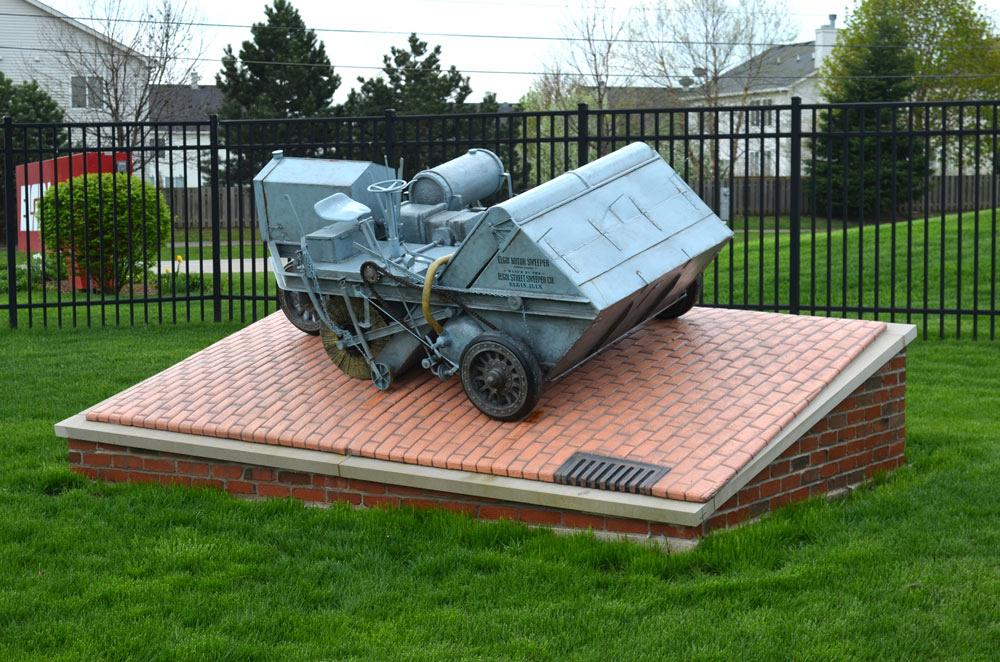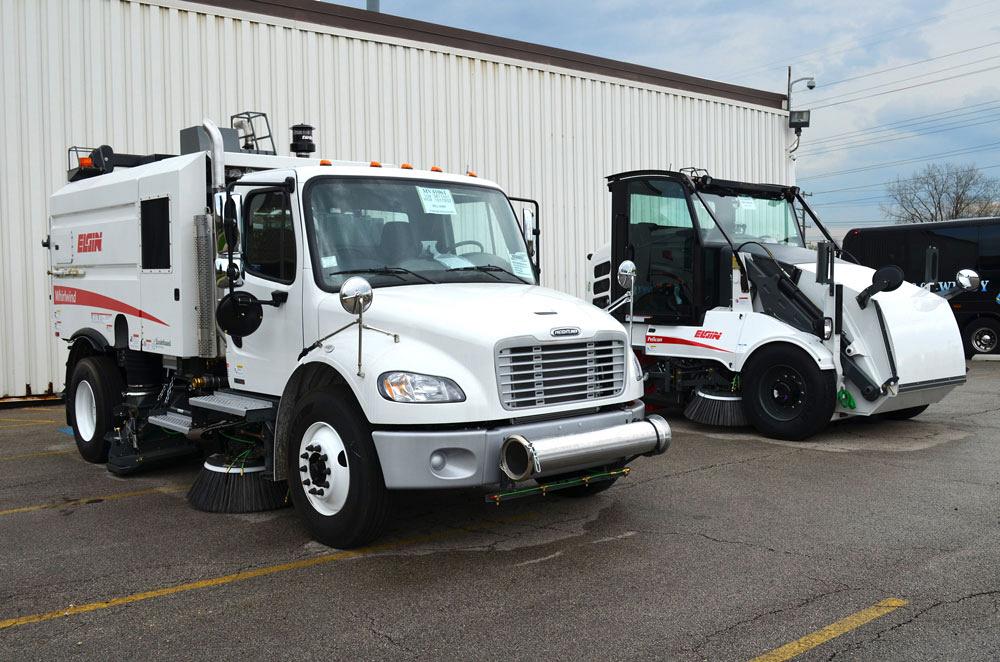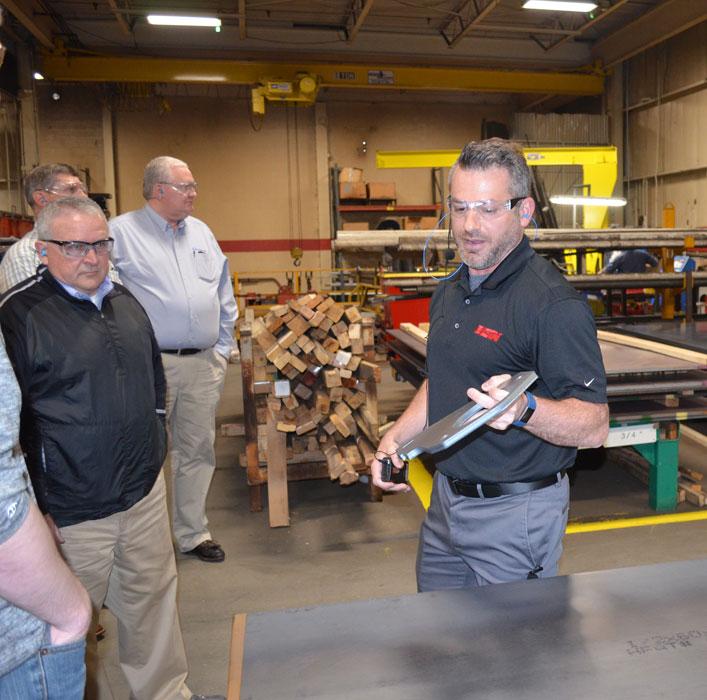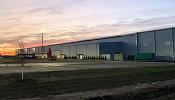Editor-in-Chief
- FMA
- The Fabricator
- FABTECH
- Canadian Metalworking
Categories
- Additive Manufacturing
- Aluminum Welding
- Arc Welding
- Assembly and Joining
- Automation and Robotics
- Bending and Forming
- Consumables
- Cutting and Weld Prep
- Electric Vehicles
- En Español
- Finishing
- Hydroforming
- Laser Cutting
- Laser Welding
- Machining
- Manufacturing Software
- Materials Handling
- Metals/Materials
- Oxyfuel Cutting
- Plasma Cutting
- Power Tools
- Punching and Other Holemaking
- Roll Forming
- Safety
- Sawing
- Shearing
- Shop Management
- Testing and Measuring
- Tube and Pipe Fabrication
- Tube and Pipe Production
- Waterjet Cutting
Industry Directory
Webcasts
Podcasts
FAB 40
Advertise
Subscribe
Account Login
Search
Staying safe in tight spaces
13 ways that Elgin Sweeper keeps employees safe in a very active manufacturing environment

Figure 1
This early model of the Pelican street sweeper was named for the large mechanical bin in the front that is similar to the bird’s large throat pouch.
As a company approaching its 103rd anniversary, Elgin Sweeper Co. has quite the manufacturing story to share.
The Elgin, Ill.-based company is essentially the inventor of the street sweeper. A city alderman came up with an early concept and shared the idea with the founders of Elgin Sweeper, which then produced the first model (see Figure 1). The basic idea of having a mechanism sweep the street surface and deposit the loose material into a bin housed in the vehicle is still in use in the modern vehicles produced today (see Figure 2).
After selling that first sweeper to the town of Boise, Idaho, the company set forth on a manufacturing journey that has dominated a market segment for more than a century, while maintaining manufacturing facilities in Elgin. In fact, the company has had only two locations during its existence: a downtown site on the Fox River, where the Grand Victoria riverboat casino docks, and its current home on the east side of town, where it has about 200,000 square feet of space.
Elgin Sweeper moved to its “new” location in 1967. As the company has grown over the years, it has maintained manufacturing at the same location even when space was tight on the shop floor. While the manufacturer won’t reveal sales numbers for its street sweepers, you just need to know that the facility is cranking out vehicles on a regular basis. The Pelican, a three-wheel mechanical sweeper, is one of the company’s primary product lines. It has a dedicated, seven-station assembly line, where the vehicle stays at each station for only a few hours at most. An additional assembly line is dedicated to Elgin Sweeper’s chassis-mounted vehicles, of which there are seven models. Here, the vehicles may not move from an assembly station for several days.
In many instances, the products are marked by a great amount of customization. One community might want steering wheels on the right side in its sweepers; others might request a water-spraying feature to minimize dust. Customers in California are more likely to inquire about compressed natural gas engines.
“Many of our configurations are one of a kind. Each is very customized,” said Eric Larson, Elgin Sweeper’s plant manager.
So you have a manufacturing facility with tight quarters, a lot of shop floor personnel (about 200 hourly employees), large vehicles that differ from each other on three major assembly lines, and manufacturing support departments that keep humming to keep those assembly lines stocked with parts that are needed for the day’s work (see Figure 3). Needless to say, it can be a challenge to keep folks safe as the heavy parts are being manipulated in workcells and moved around the factory floor. It was also a major reason that Elgin Sweeper had a total case incident rate that was about seven times higher 10 years ago than where it stands today.
Larson spoke at the Fabricators & Manufacturers Association’s Safety Conference in Elgin, Ill., in April and offered up several reasons as to why they have been able to sweep in a new safety culture.
No. 1: Lean on Experienced Personnel
Some may view veteran employees as a detriment to a good safety record because they may have developed bad habits over time, but Larson said that the knowledge and experience of these veterans are a huge benefit. Because employee turnover is low, management does not have the need to spend valuable manufacturing time training new people about safety practices.
The average tenure at Elgin Sweeper is 12 years. More than 60 employees have 25 years of work experience. They all know what is expected and have done well in participating in changes aimed at keeping everyone safer.

Figure 2
The chassis-mounted street sweeper and the modern-day version of the Pelican represent the two vehicle types that come off Elgin Sweeper’s three assembly lines.
No. 2: Find a Champion
Even with the experienced workforce, however, the downturn in recordable injuries only began when someone was hired to spearhead dramatic change. Elgin Sweeper had relied on a safety professional from a sister company within the corporate family, but that part-time presence really didn’t create the impetus for the change that was needed.
“We had a workforce that had been here for a long time. We were doing some safety things, but we weren’t continuously rallying around the idea of safety,” Larson said. “We needed more sustained involvement with the employees to improve our safety record.”
In 2007 Elgin Sweeper hired a full-time environmental, health, and safety (EHS) manager. This position was created to go beyond simply handling reporting. “The new EHS manager started challenging us,” Larson said.
No. 3: Get Everyone Involved
One of the first things the new safety manager did was form a safety committee comprising hourly employees and some supervisors. The group of 10 to 12 is charged with looking at safety trends, such as near misses and recent injuries that have occurred on the shop floor, and projects that can be undertaken to address these concerns.
For example, the safety committee was recently charged with researching and evaluating the need for motorized cranes to move heavy loads (see Figure 4). The committee surveyed the entire plant and delivered a list of about 10 areas where the motorized cranes would improve ergonomics. As a result, those suggestions were worked into capital improvement plans and will be addressed in the near future.
No. 4: Take and Act on Suggestions
You have to start somewhere on any journey, so that’s why Elgin Sweeper asks for suggestions from its workforce on areas to improve safety. Actually, the company incentivizes its employees to come up with ideas. As part of the metric to earn merit increases, employees must submit safety suggestions. If one of the suggestions is implemented, the employee receives a small payout.
Borrowing from some of its lean training, Elgin Sweeper has safety blitzes, which are inspired by kaizen events in which a small, cross-functional team comes together to explore safety issues and devise ways to solve them. Larson said as many as 20 safety suggestions can be addressed and remedied over a two- or three-day period.
No. 5: Make Supervisors Accountable
In the days prior to 2007, supervisors were not tasked with establishing a safe work environment. Surprisingly, the only metric that was tracked was injuries, which didn’t do much to prevent future accidents because nothing was formally done to avoid similar injuries in the future. Workplace safety at this point in time was really a reactive process instead of a proactive process, according to Larson.
Today supervisors are evaluated on six different safety-related measures. Because of job safety audits, numbers are available to reflect how effective safety efforts have been. If safety is an issue, the supervisor might have an issue obtaining a merit increase as well.
No. 6: Gather Data
Arguably the biggest change in data collection as it related to safety at Elgin Sweeper was simply keeping track of near misses. What was just a case of “Wow! That was close.” more than a decade ago is now viewed as an opportunity to find the root cause of the almost-accident, implement a solution to avoid an injury in the future, and instruct others of what was done to keep everyone informed.

Figure 3
During a recent tour of Elgin Sweeper, Pete DiBenedetto talked about the manufacturer’s effort to minimize inventory levels and fabricate only the parts that are needed for the day’s jobs. As an example, he held up a laser-cut part that was destined for use in a downstream operation on the next shift.
Larson said that one of Elgin Sweeper’s large-scale efforts is tracking soft-tissue injuries. After what looked to be a spike in these types of injuries, the company began to modify its training. That has led to about five minutes of stretching before each shift to loosen muscles and to help employees clear their minds to focus on the work before them. Elgin Sweeper also looks to avoid extreme repetition of activities, which may occur when an employee does the same thing over and over for multiple shifts at a time. To keep the work fresh, employees are cross-trained and moved around to different types of jobs, which helps to minimize repetitive movements that could lead to injury.
No. 7: Recognize Good Habits
By 2008 Elgin Sweeper was trying to heighten its safety awareness, and that’s when it took more steps to make it hard for employees to ignore injury prevention efforts.
One such program was simply called “Thank You for Working Safely.” If supervisors or safety professionals see someone working in a safe manner, they can present a token to the employee, which is redeemable in the company’s vending machines.
“We want to do a better job of celebrating success,” Larson said. “If you are wearing your personal protective equipment or you are wearing that safety harness properly, that’s excellent. Give them a token. It reinforces their safe work habits in a positive way.”
No. 8: Share Information
You see communication boards in almost every manufacturing company around the world, and there is a reason for this. Communication boards are a simple and effective visual tool to keep a message alive and in the minds of those that walk past that board every day.
Elgin Sweeper uses a dedicated Safety Communication Board to keep employees updated on areas of concern, upcoming safety events on the calendar, and contact information for key safety officials.
No. 9: Get Everyone Involved in Auditing
While Elgin Sweeper doesn’t do anything as formal as the DuPont Safety Training Observation Program (STOP), it does ask that its employees carry a booklet with them in which they can jot down observations before starting their shift.
“It forces them to step away for 15 minutes and make sure that everything that is about to be done is going to comply with the way it should be done,” Larson said.
No. 10: Address Safety Right Away
Every new hire is required to go through the company’s safety orientation program with someone who is deeply familiar with Elgin Sweeper.
A new hourly hire is likely to start on a temporary basis. The agency that supplies temporary employees gives a small amount of safety training, but once the employees start at Elgin Sweeper, they participate in a three-hour safety presentation on the first day. They don’t head out to the shop floor until that is completed.

Figure 4
To make life easier for shop floor employees, Elgin Sweeper installed motorized cranes for lifting heavy parts and lift tables that can adjust to the level that is comfortable for the employee.
The company has accomplished this with two full-time safety professionals available on-site for these orientations. The EHS manager also spends some of his time working with sister companies within the Federal Signal corporate family. (Federal Signal acquired Elgin Sweeper in 1982.)
No. 11: Bring in a New Pair of Eyes
Supervisors and employees are involved with the auditing of safety practices at Elgin Sweeper. How has the company sought to improve on this effort?
Larson said that it asks employees to do audits of other areas of the facility on a monthly basis. Management might ask someone from finishing to audit the machining department, for example, because a fresh pair of eyes may see a solution that those closest to the department can’t see.
All employees have a check list that is tailored to the particular department they are auditing, and they are provided with coaching if they are hesitant to enter someone else’s territory and to undertake a critical overview.
No. 12: Practice 5S
When many companies begin their lean journeys, they usually begin with a 5S campaign. (5S is a workplace organization methodology based on Japanese principles that when translated all begin with the letter “S.” The rough translation is sort, set in order, shine, standardize, and sustain, all of which contribute to an environment where an individual does his job in the most efficient way possible.)
Elgin Sweeper has made 5S a part of its production efforts since 2009, and now the payoff is evident to guests who walk the shop floor. Skids full of parts no longer force people to dance around the shop floor. Aisles are clean, and pathways throughout the facility can accommodate lift trucks and foot traffic, even with a minimum of open space.
All employees are expected to clean up and organize their work areas before they leave. Larson said they are paid to do that, so it is included as part of their regular job duties each day.
No. 13: Know What Employees Are Asked to Do
In 2013 Elgin Sweeper took a good look at its job functions to determine just what physical demands were expected of their employees. Every job was scrutinized to see if it was putting unavoidable stress on the individual, which could lead to long-term injuries.
For instance, what jobs required workers to lift a minimum of 50 lbs.? Did that weight limit still make sense? Were electronic assists available that made that standard obsolete?
After consulting with a medical professional about the tasks associated with the job functions, company management now believes it has the best set of criteria to match a person to a job and to be reassured that the individual can perform the tasks associated with the job without being injured.
Larson notes that Elgin Sweeper always strives to keep employees safe and improve the company’s ongoing safety record. Recent safety statistics suggest that the company has made huge strides since 2006. In 2014 the manufacturer set a record of 906 days without a lost-time accident; two years later, the company approached this record again, achieving 869 days.
That’s quite a milestone for a company more than 100 years old. It’s safe to say that the next 100 years should prove to be just as noteworthy.
Elgin Sweeper Co., 847-741-5370, www.elginsweeper.com
About the Author

Dan Davis
2135 Point Blvd.
Elgin, IL 60123
815-227-8281
Dan Davis is editor-in-chief of The Fabricator, the industry's most widely circulated metal fabricating magazine, and its sister publications, The Tube & Pipe Journal and The Welder. He has been with the publications since April 2002.
subscribe now

The Fabricator is North America's leading magazine for the metal forming and fabricating industry. The magazine delivers the news, technical articles, and case histories that enable fabricators to do their jobs more efficiently. The Fabricator has served the industry since 1970.
start your free subscription- Stay connected from anywhere

Easily access valuable industry resources now with full access to the digital edition of The Fabricator.

Easily access valuable industry resources now with full access to the digital edition of The Welder.

Easily access valuable industry resources now with full access to the digital edition of The Tube and Pipe Journal.
- Podcasting
- Podcast:
- The Fabricator Podcast
- Published:
- 05/07/2024
- Running Time:
- 67:38
Patrick Brunken, VP of Addison Machine Engineering, joins The Fabricator Podcast to talk about the tube and pipe...
- Industry Events
Laser Welding Certificate Course
- May 7 - August 6, 2024
- Farmington Hills, IL
World-Class Roll Forming Workshop
- June 5 - 6, 2024
- Louisville, KY
Advanced Laser Application Workshop
- June 25 - 27, 2024
- Novi, MI
Precision Press Brake Certificate Course
- July 31 - August 1, 2024
- Elgin,































